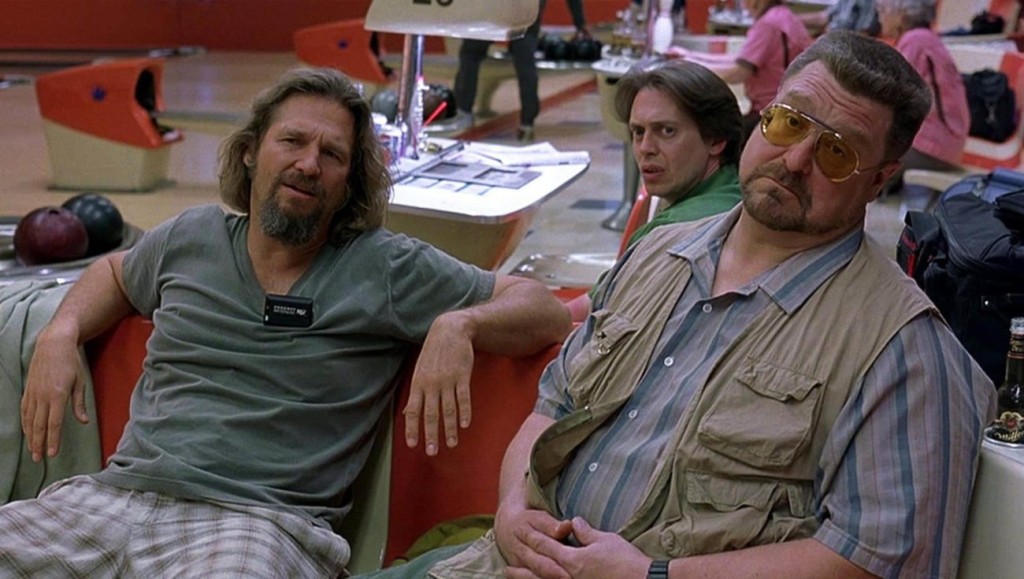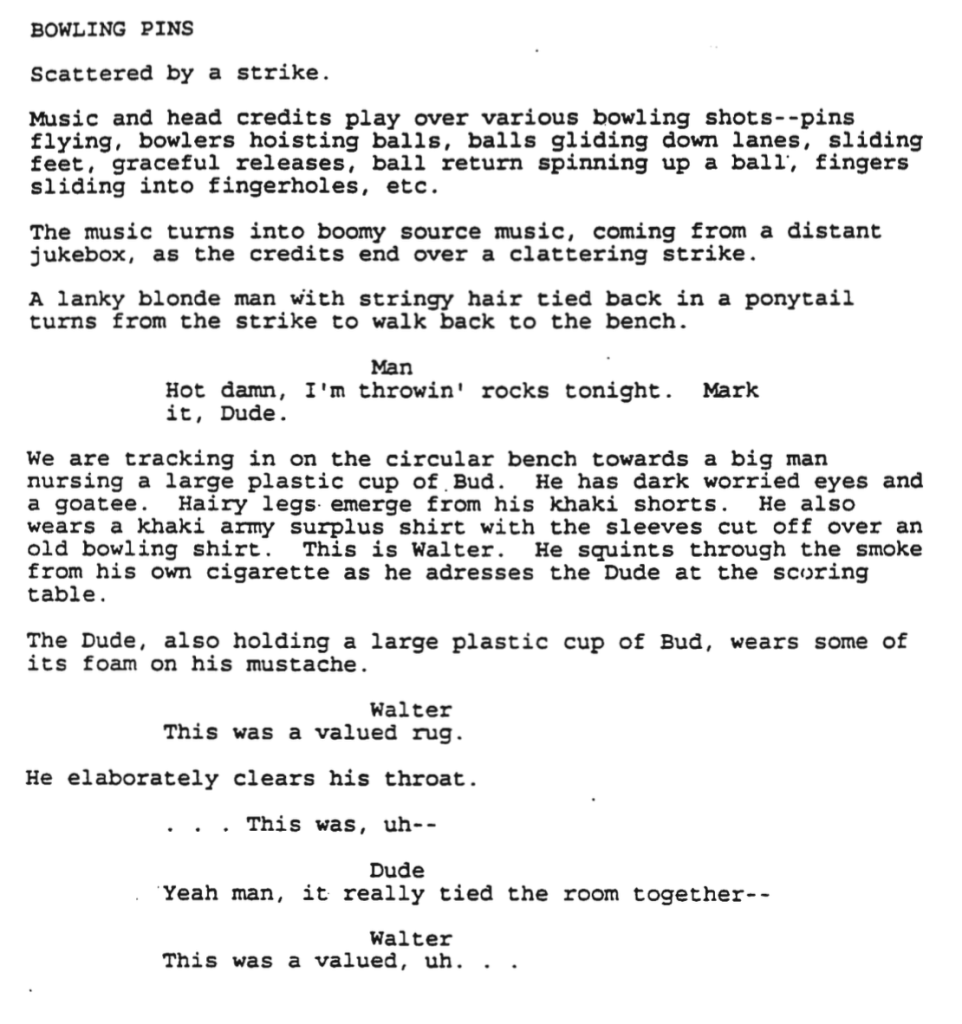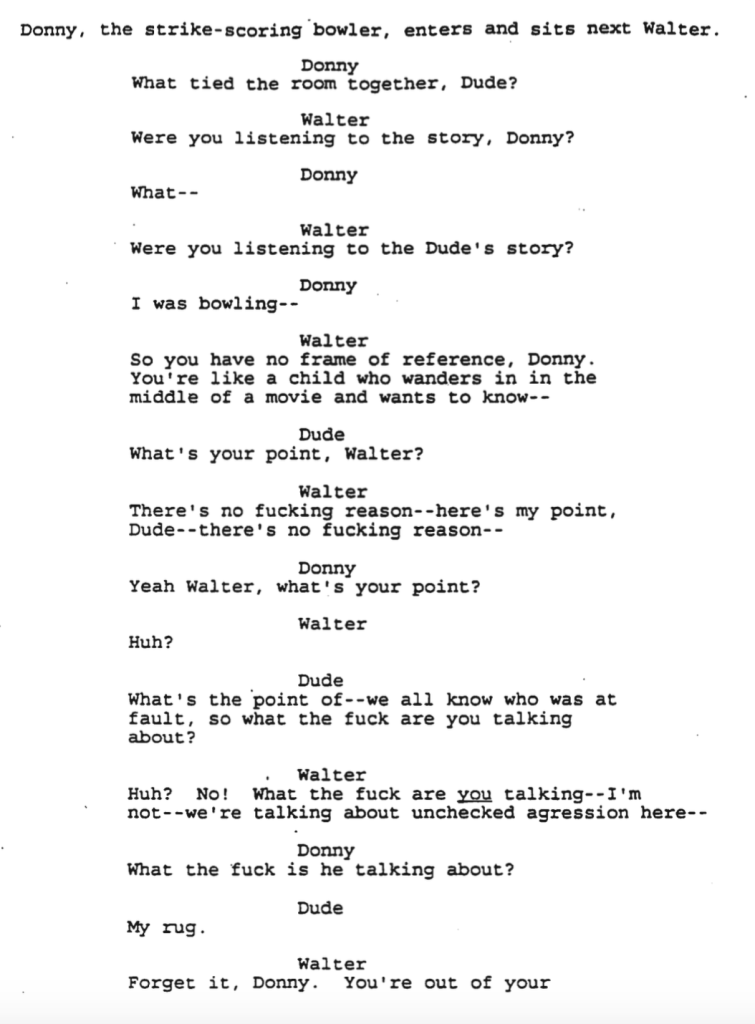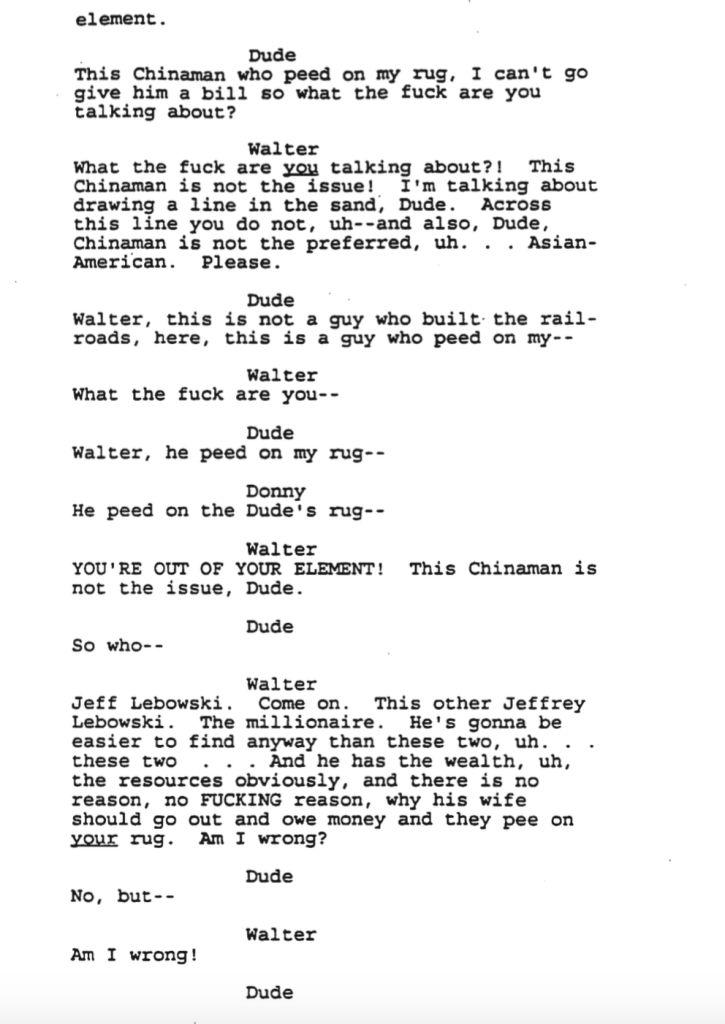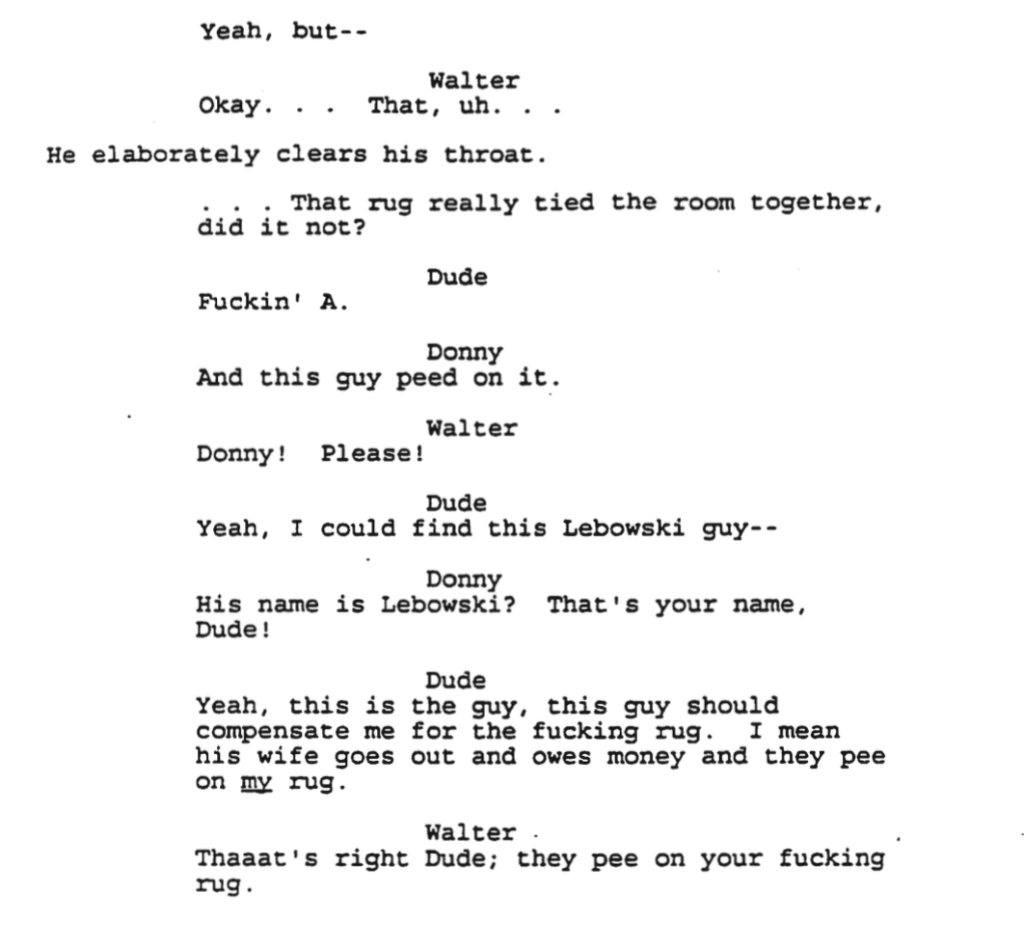DIALOGUE WEEK IS HERE! – All this week, I’ll be breaking down dialogue scenes from movies you love.
I thought a lot about how I was going to frame this week’s entries and I decided that the best way to go about it was to present a scene from a well-known movie, post that scene so we could all read it, then go through all of the creative and technical reasons why the scene resulted in good dialogue. If you have suggestions for tweaks, share them in the comments.
The Coen Brothers were an easy choice for Day 1. They have a number of scripts with numerous high-quality dialogue scenes. I’ve talked about this scene from The Big Lebowski before but I love it so I’m going to talk about it again!
The scene in question takes place after our hero, “The Dude,” a meandering 40-something eccentric, endures a break-in where three thugs mistake him for a rich man with the same last name. They threaten him, rough him up, and to send a message, piss on his rug. The following scene takes place the next night, with The Dude partaking in his weekly bowling game with oddball friends, Walter, a fast-talking war vet, and Donny, a clueless idiot.
Hopefully you read Thursday’s Dialogue Prep article. If you didn’t, go back and read it now because that’s the first thing I want to talk about. This scene from The Big Lebowski does contain the requisite “want” and “resistance” most good dialogue scenes have. The Dude WANTS to figure out what to do about these guys who screwed up his rug. And Walter provides the RESISTANCE, telling The Dude he is focusing on the wrong damn thing.
There’s a tweak in the formula, however. A scene typically works best when the primary character wants something from the other character in the scene. But The Dude doesn’t want anything from Walter (or Donny). He wants something from the guys who broke into his house. As such, The Dude is sort of talking out loud. His want is a blanket question to which he’s trying to find a solution. In that respect, Walter’s resistance isn’t necessary. He doesn’t have anything riding on this. But he’s offering that resistance nonetheless.
The reason this still works, however, is that the setup results in CONFLICT. Remember that conflict is where dialogue pops the most. This is why Walter’s resistance is so important. If he doesn’t resist The Dude’s train of thought, there’s no conflict. It’s just two people agreeing with each other. And that’s boring. The big lesson learned here, then, is that as long as you find that conflict between the characters, you can tweak the formula.
Another thing I love about this scene is Donny. I often talk about how third characters can be a secret weapon in scenes. A third person adds an element of uncertainty to the dialogue. If two people are simply exchanging turns talking, dialogue gets monotonous. Creating this third character who’s always two beats behind everyone else is a genius move because now, not only do we have our classic “want and resist” scenario. But we’ve got these wild-card chunks of dialogue thrown into the fray that wreak havoc on the conversation. “What tied the room together. Dude?” “What the fuck is he talking about?” “His name is Lebowski? That’s your name, Dude!”
Another huge reason this dialogue is so strong is that it contains a “Dialogue Friendly” character. If you’re new to the site, “Dialogue Friendly” refers to the kind of character who’s built to have memorable dialogue. These tend to be characters who are witty, clever, eccentric, manic, boisterous, philosophical, talkative, weird, etc. This is one of the most overlooked reasons for bad dialogue. Writers have written boring/introverted/reserved characters into their story and then wonder why none of them ever says anything interesting.
Walter is possibly the most dialogue friendly character you’ll find. He’s crazy. He loves the sound of his own voice. And he’s perfectly happy offering his opinion on things. I mean, let the great dialogue roll: “Were you listening to the Dude’s story?” “I was bowling—“ “So you have no frame of reference, Donny. You’re like a child who wanders in the middle of a movie and wants to know—“ To understand the value of this line, consider that a non-dialogue friendly character probably would’ve said, “Then shut up.” Which is a line we’ve heard a million times before.
Realism. Realism is something I don’t talk about a lot on the site. But this dialogue is a good example of it. Notice how “in the moment” the conversation is. For example, Walter cuts himself off mid-sentence to follow another thought. “What the fuck are you talking about?! This Chinaman is not the issue! I’m talking about drawing a line in the sand, Dude. Across this line you do not, uh–and also, Dude, Chinaman is not the preferred, uh. . . Asian-American. Please.”
I find that writers spend so much time polishing their dialogue so that every line is the screenwriting equivalent of the Mona Lisa, that they lose that “in the moment” quality. In the moment is messy. It’s dirty. It’s the kind of place where characters can change their line of thought mid-sentence.
On top of that, everyone’s cutting each other off, talking over each other. There are a lot of dashes at the end of sentences. For newbies, when you want someone to cut someone else off or talk over them, you add two dashes. Not ellipsis (three dots). I know immediately I’m dealing with a beginner when I see this mistake.
Also, the characters are all DOING something (bowling) while they’re talking. What they’re doing is pretty insignificant. But it made the dialogue more interesting than if, say, the scene had taken place back at The Dude’s apartment with everyone standing around. When you have your characters somewhere DOING STUFF, it often provides new ideas and directions to take the dialogue that you wouldn’t have thought of before.
For example, maybe an early version of this scene had these three discussing the matter cohesively. Then either Joel or Ethan thought, “Wouldn’t it be funny if Donny’s off bowling so he comes into the interaction late, leaving him to play conversation catch-up the whole time?” And hence we get a much funnier version of Donny than we would’ve had these three NOT been at the bowling alley.
One final observation. It’s a small one, but I think it’s worth talking about. I love this little thread about how great the rug was. “That was a valued rug,” is the first thing that Walter says. “Yeah, man, it really tied the room together,” The Dude replies. “What tied the room together, Dude?” Donnie butts in. Then later, Walter goes back to that well, “That rug really tied the room together, did it not?” Technically, none of this needs to be discussed. You could’ve easily written the scene like this…
“I can’t believe he did that to my rug.” “You need to get him back. That’s what you need to do.” “But how. I don’t even know who these guys are.” “Screw those guys. Go after the guy with your name. Lebowski. He should be paying you back for that rug.” “That’s not a bad idea.” “I know. Now let’s bowl. I’m feeling good tonight.” Walter confidently struts up and bowls a gutter ball.
Notice how I could insert this scene for the one the Coens wrote and it would still TECHNICALLY get the job done. Relevant plot points are hit. We know what needs to happen next. But it’s missing stuff like the tangent thread I just highlighted. And the talking over each other. And the third guy butting in. And cashing in on your dialogue-friendly character. And that’s probably the point we should leave on. Is that when it comes to dialogue, it’s never ONE THING that makes the scene. It’s a combination of things. That’s definitely the case with this scene from The Big Lebowski.
What I learned: Use your environment to improve the dialogue in your scene. If there’s nothing in the immediate environment that can achieve this, consider moving the scene to a different environment. I love how the simple act of bowling his turn places Donny behind the conversation by a few beats, which in turn provides several great jokes within the interaction.
Carson does feature screenplay consultations, TV Pilot Consultations, and logline consultations. Logline consultations go for $25 a piece or 5 for $75. If you’re interested in any of these consultation packages, e-mail Carsonreeves1@gmail.com with the subject line: CONSULTATION. Don’t start writing a script or sending a script out blind. Let Scriptshadow help you get it in shape first!

